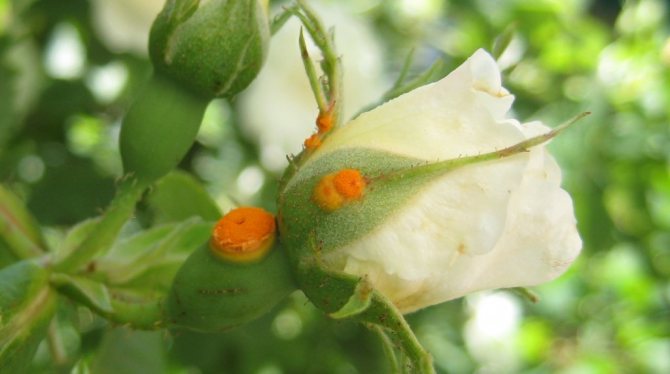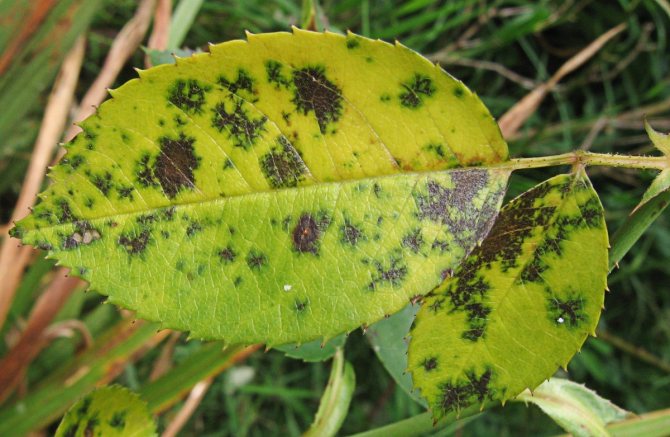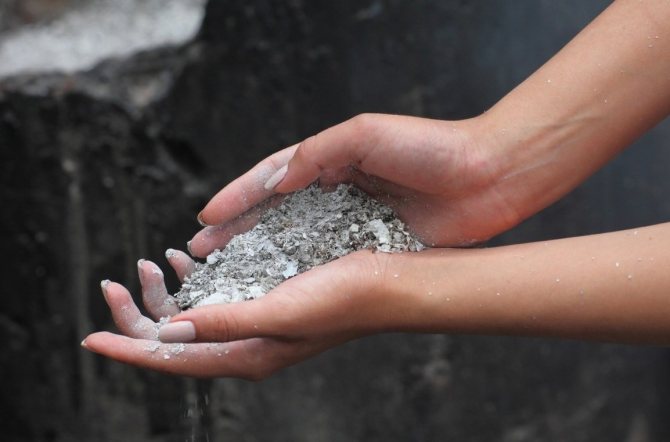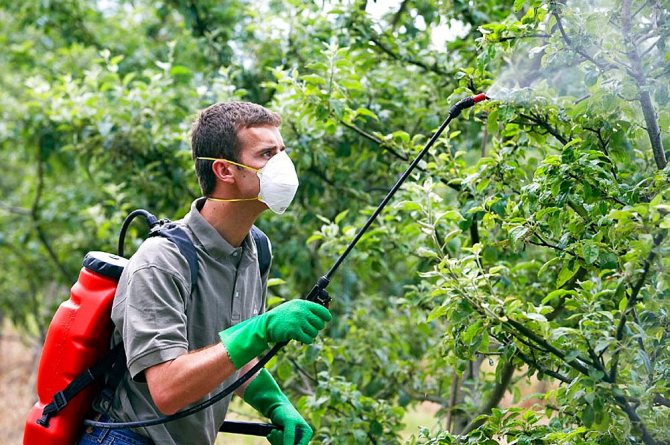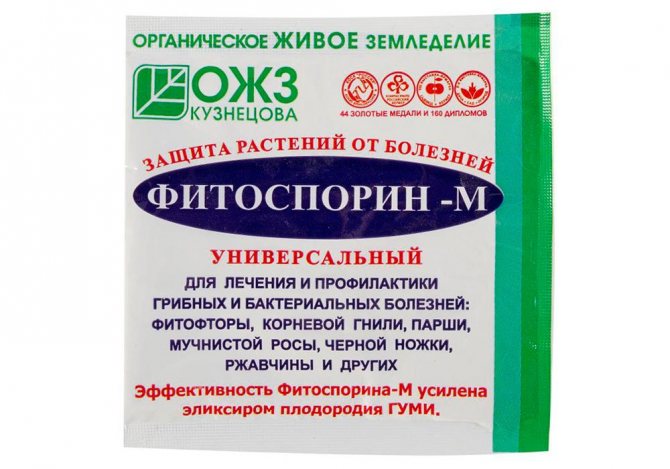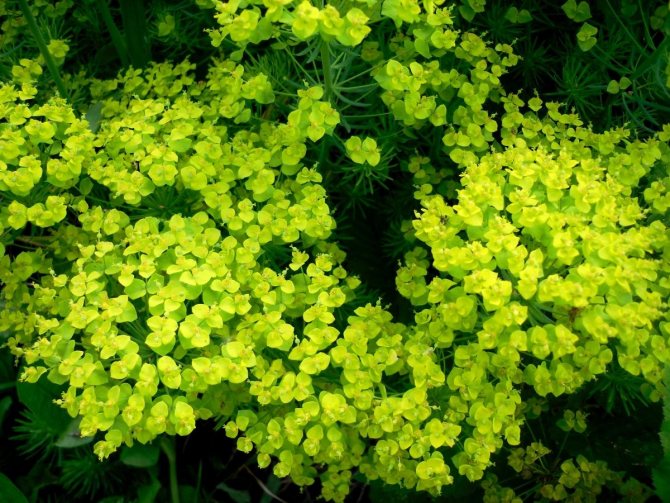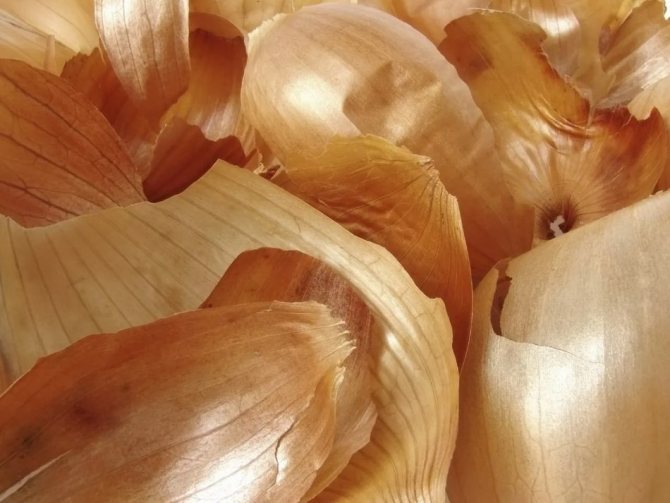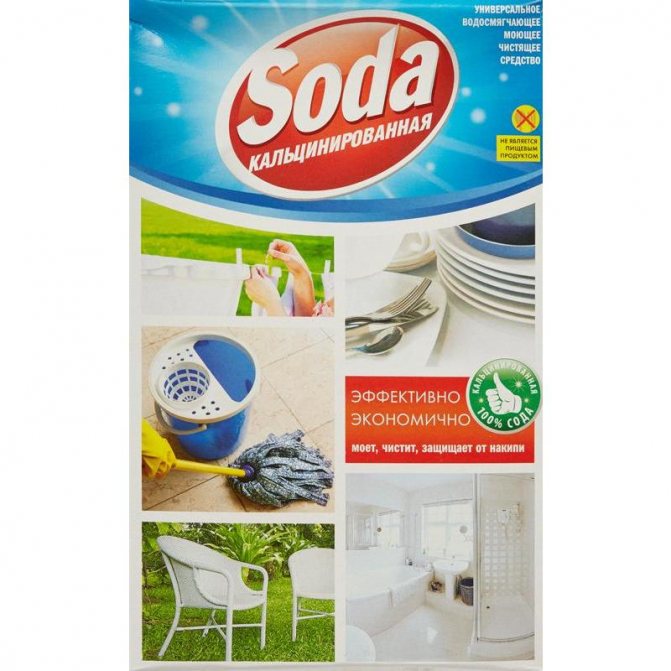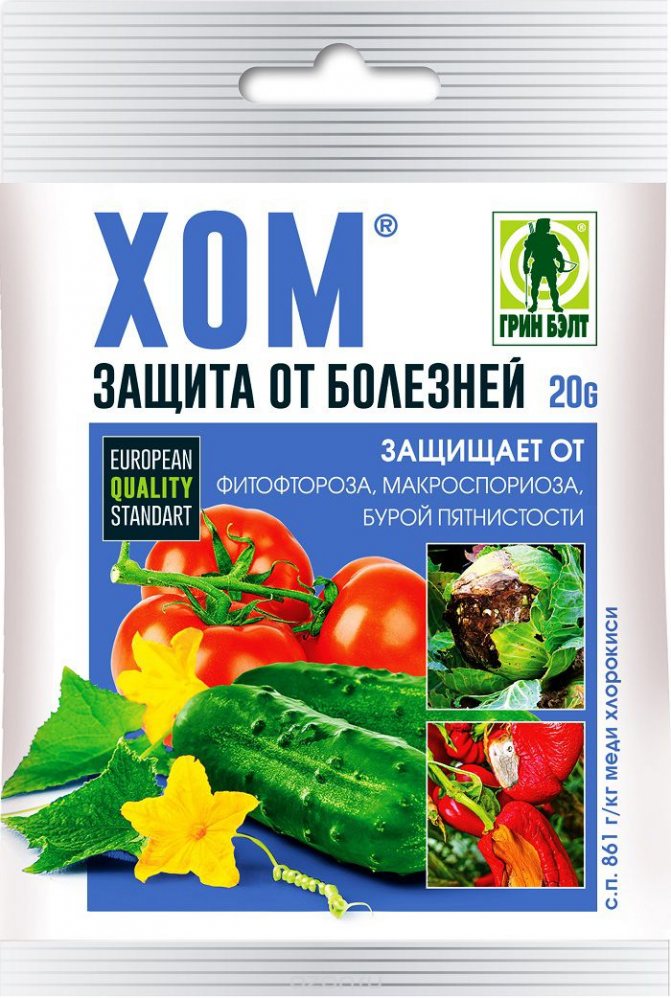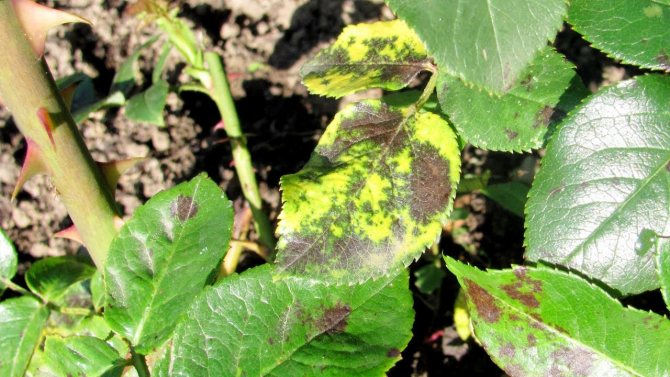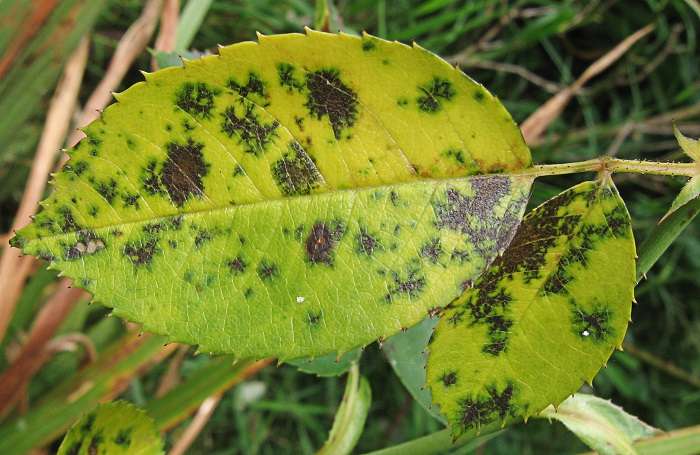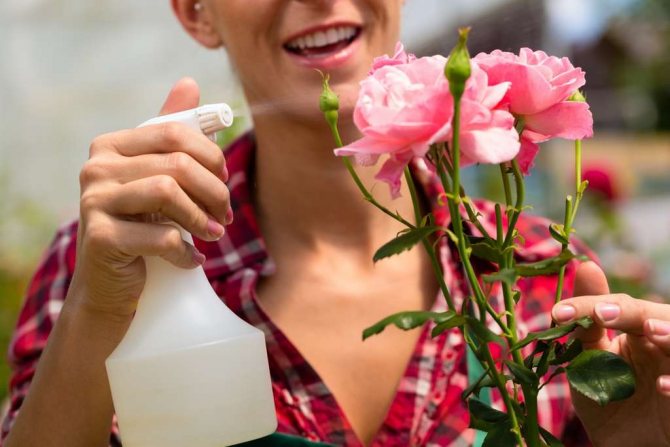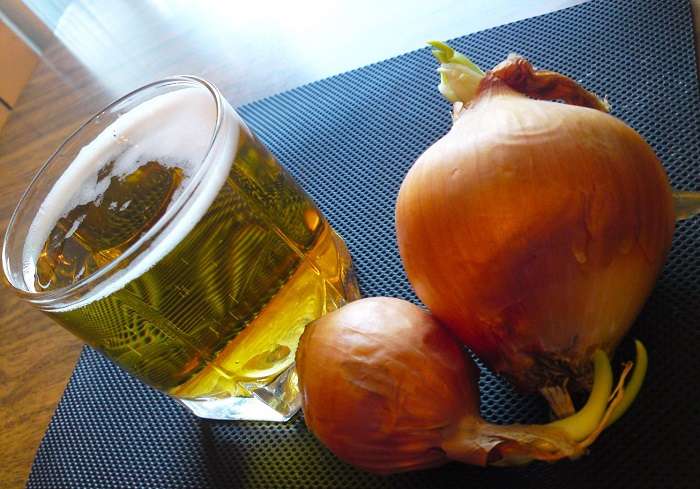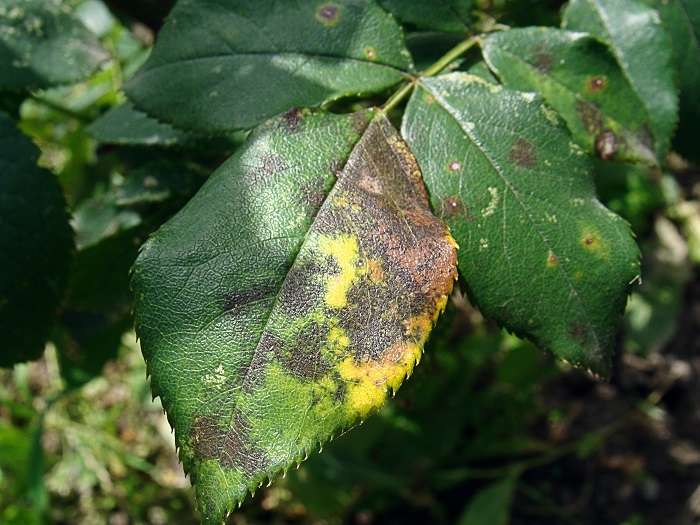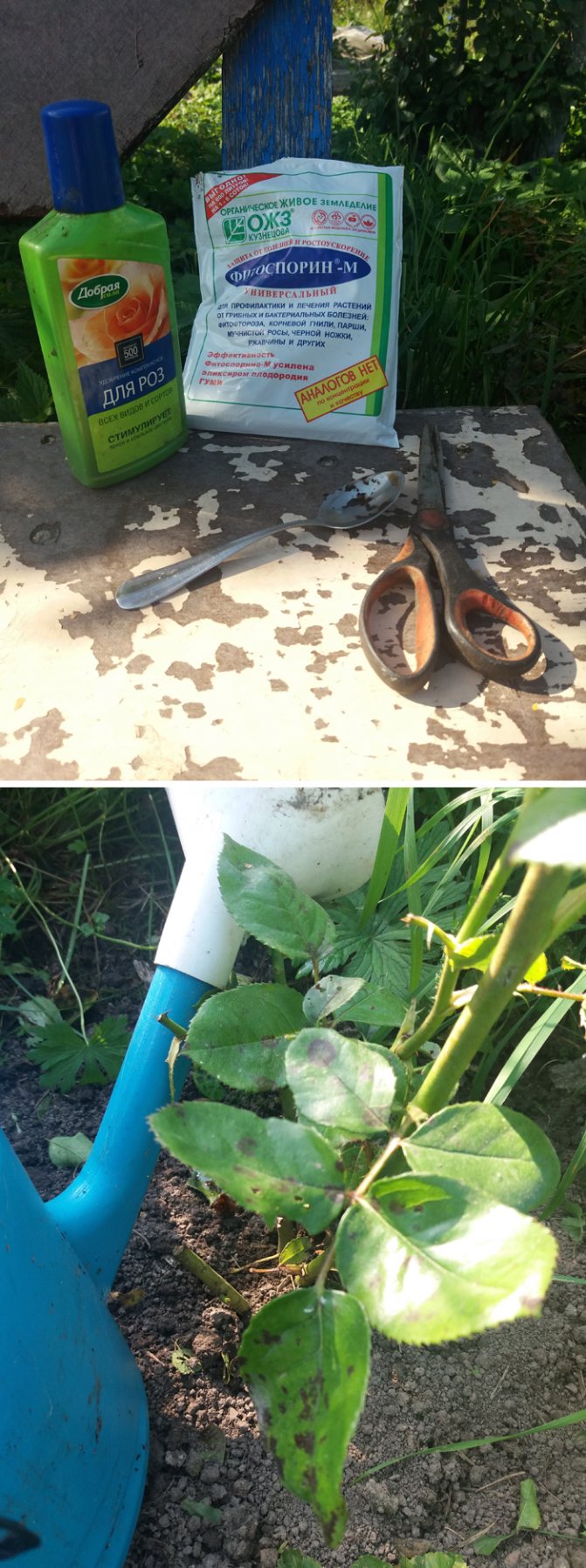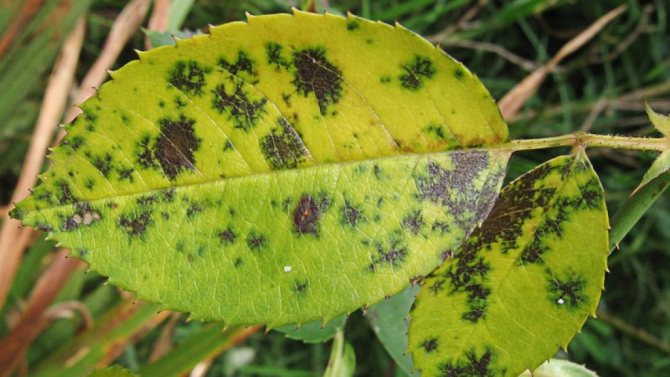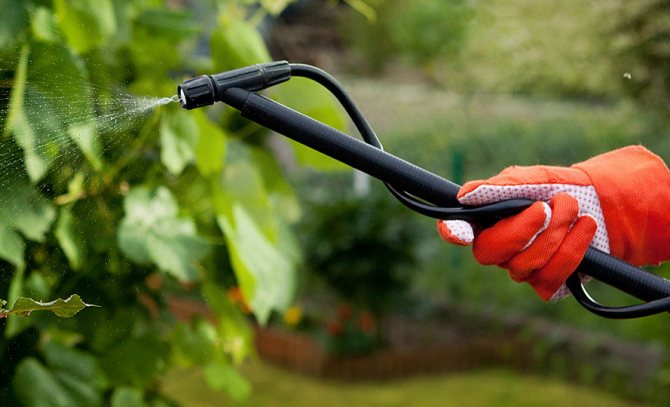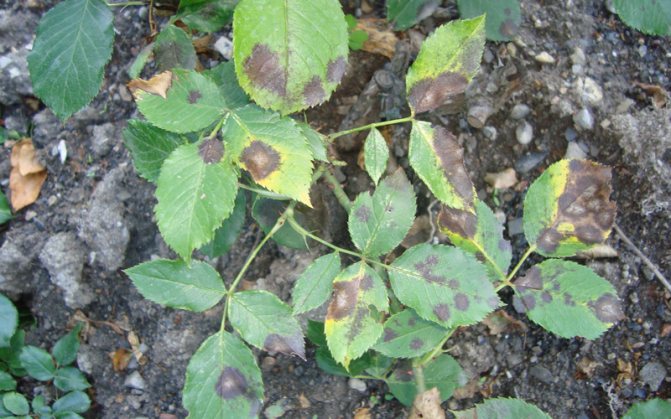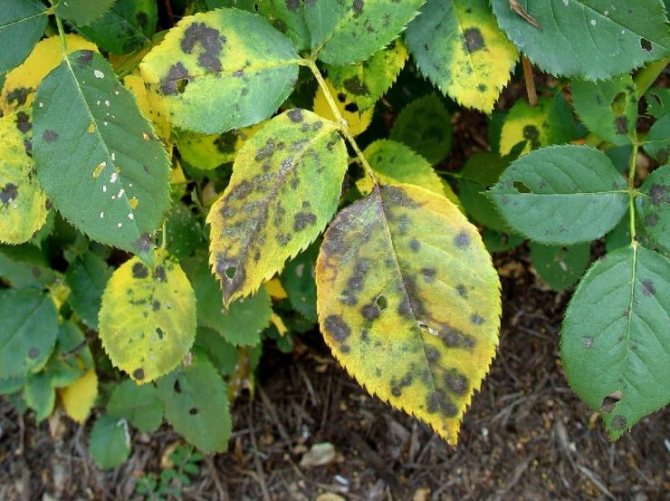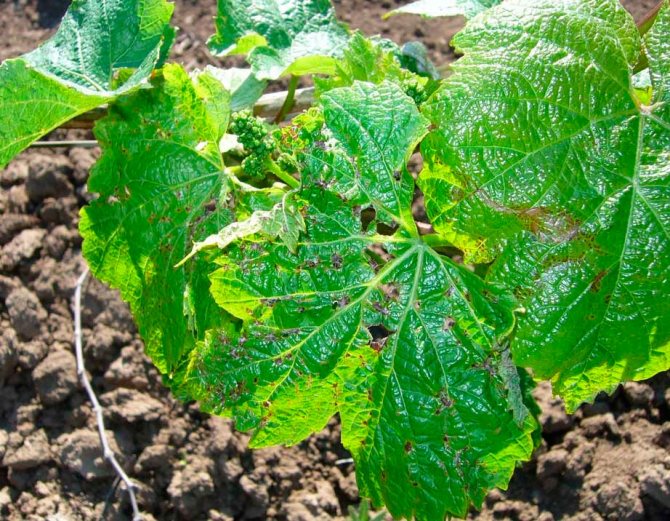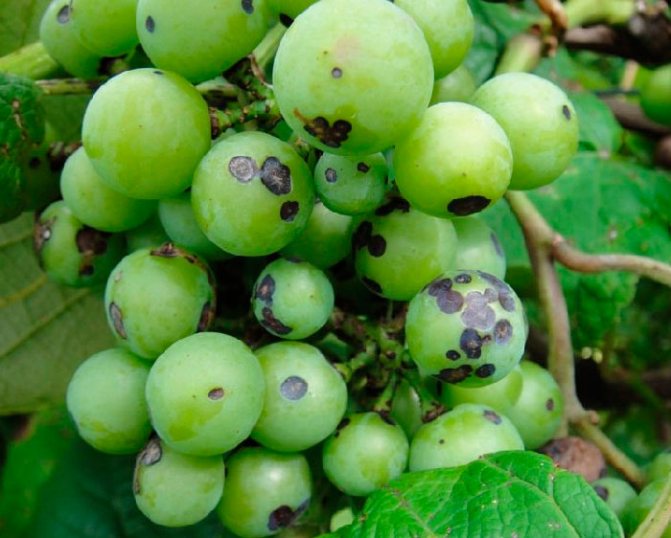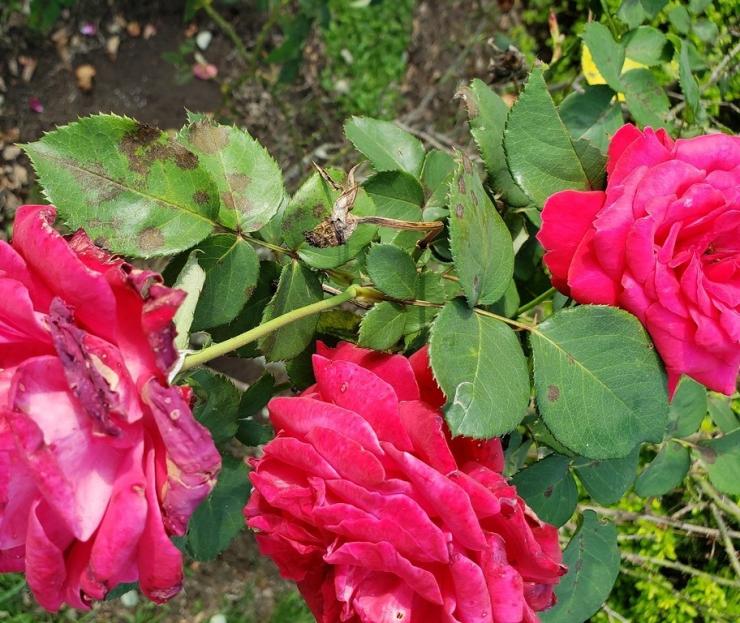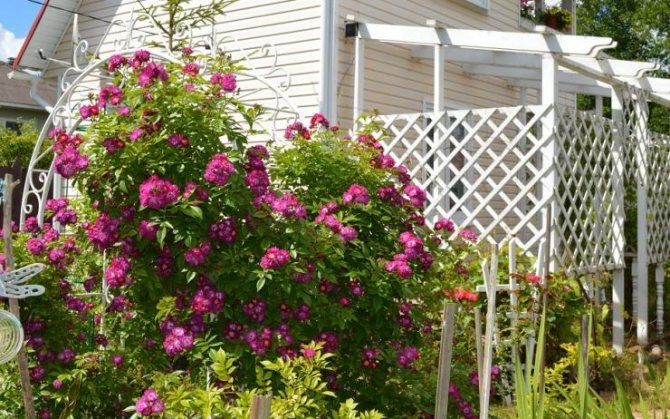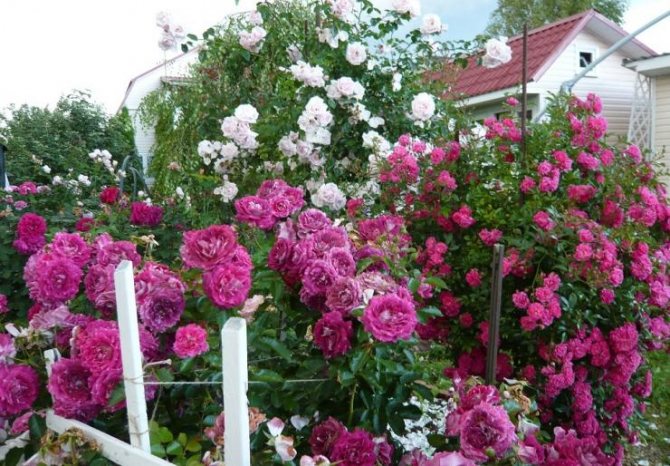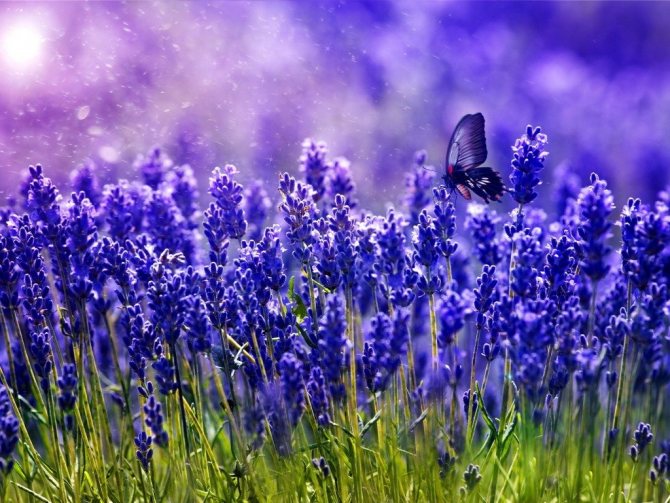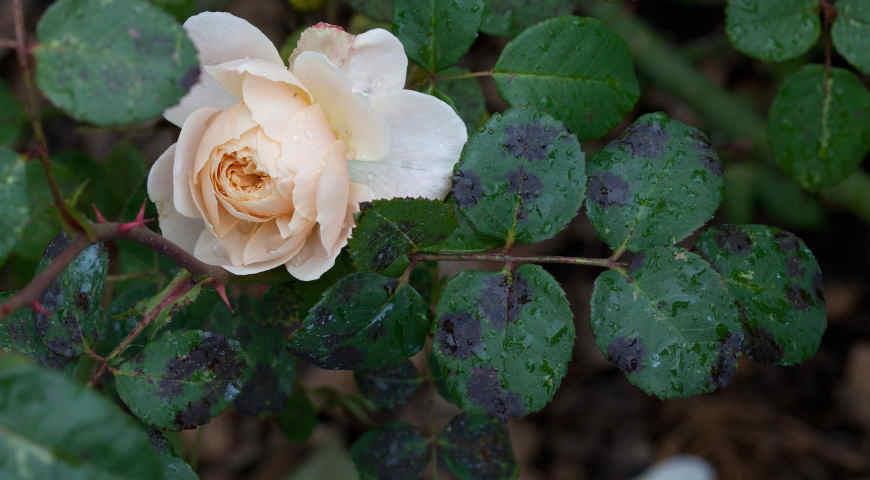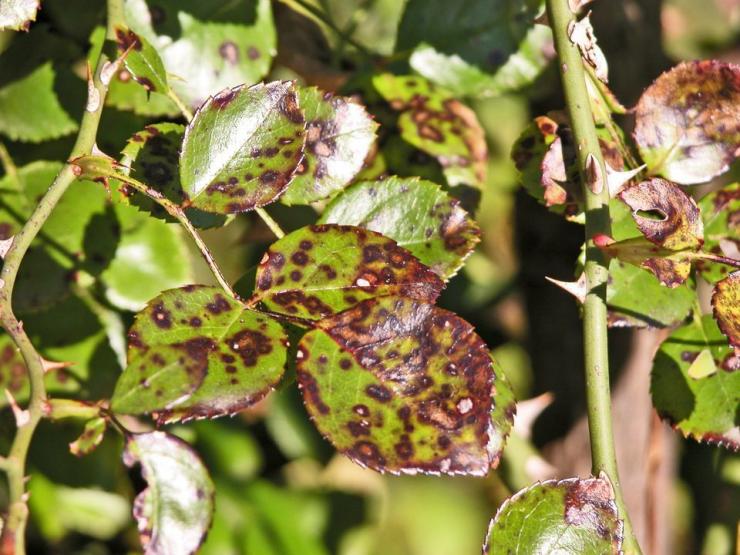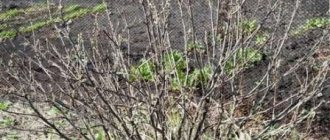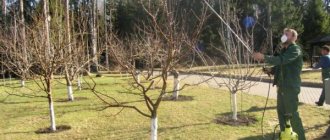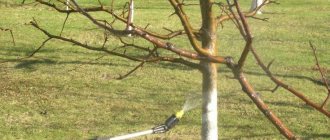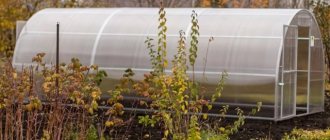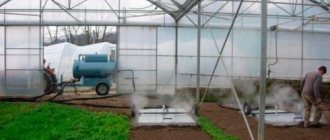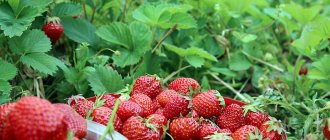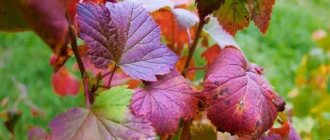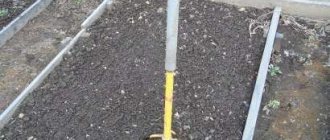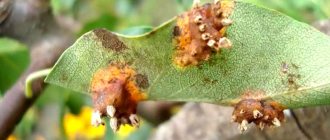The queen of the garden, the rose, is not ignored not only by the person. Numerous diseases, pest attacks damage the health and beauty of the gardeners' favorite. The rose is especially vulnerable in early spring, since it has weakened over the winter. Therefore, it is very important to process roses with high quality after winter in order to prevent infection of the bushes with infections, to protect them from the first hungry pests.
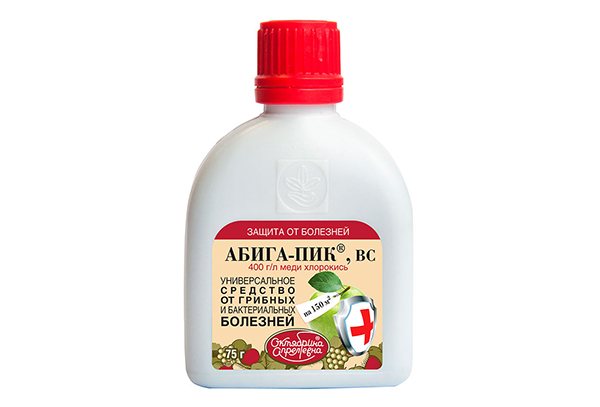
What it is
The common name of these drugs very accurately explains their purpose. The word "fungicides" is translated from Latin as "mushroom killer". But how do they do it? Can you do without them?
Spores of fungi spread easily and quickly by air, they are carried by slugs, larvae and insects. Once in favorable conditions, they germinate and form mycelium. These diseases have become the scourge of all cultivated plants in recent decades. Potatoes, tomatoes, cucumbers suffer from them. As a result, the proximity to diseased plants of other species can also lead to diseases of roses. To save roses from all these dangers, fungicides are used.
Fungicidal substances act on mycelium spores, inhibiting their development and preventing spread. They belong to one of the pesticide groups. They have both prophylactic and therapeutic effects. This feature makes them vital for roses.
But their effectiveness depends on many factors:
- climatic conditions;
- soil features;
- neighborhood with other plants.
In addition, fungi, like all protozoa, easily mutate and adapt to adverse conditions. They quickly develop resistance (resistance) to the action of a certain type of fungicide.
Therefore, these drugs are constantly being improved. As a result, the market offers a huge number of them. It is difficult to navigate this range without knowing the types of fungicides and the specifics of their use.
Many fungicidal preparations have been developed, differing in:
- chemical properties;
- action on the pathogen;
- nature of use;
- distribution over plant tissues.
All fungicides are divided into two fundamentally different types:
Chemicals - these are toxic substances that kill the fungus through their chemical compounds.
Biological agents - practically harmless drugs. They use a non-chemical effect on pathogenic fungi. For example, bacteria that can kill them.
Chemicals
Depending on the chemical origin, these funds are:
Inorganic fungicides contain compounds of sulfur, copper, iron, mercury, manganese, boric acid. The table below lists some of the names of the active ingredients and the fungicides that contain them.
| Active substance | Fungicide |
| Sulfur | Lime-sulfur broth, colloidal sulfur, Tiovit Jet |
| Copper | Copper chloride, copper sulfate, Champion, Kuproksat, Medyan extra |
| Iron | inkstone |
| Mercury | Chlorine mercury |
Chemical organic fungicides do not contain heavy metals. They are decomposed by microorganisms and soil bacteria. It is very easy to prepare aqueous solutions from them and combine with other pesticides. The table below shows examples of such drugs.
| Chemical group | Fungicide |
| Carbamates | Tattu, Infinito |
| Dithiocarbamates | Bogatyr, Ordan, Raxil |
| Morpholirny | Cabrio Duo, Acrobat |
| Imidazoles | Alpha Treater, Mirage |
| Triazoles | Skor, Topaz, Soligor |
| Strobilurins | Strobe, Amistar, Boxwood |
Pathogenic fungi develop resistance to all fungicides belonging to one chemical group at once. Therefore, in the absence of a positive effect, choose a drug from a different chemical group.
The disadvantage of chemical fungicides is that they are toxic. When working with them, you must take precautions.
Spraying rose bushes with fungicides is carried out only in closed clothing and gloves. It would be nice to purchase a respirator for these purposes, since poisons easily penetrate the human body through the skin and respiratory tract. They usually remember about gloves, but forget about a respirator. And in vain - a very necessary thing in the household, and not only in the garden and vegetable garden.
Plants are treated with fungicides in calm, sunny weather, in the morning or evening. If it rains after spraying, spraying should be repeated at a more favorable time.
To avoid addiction, fungicides must be alternated.
Get a quality sprayer. It will reduce the cost of purchasing drugs, will not fray your nerves and will make your work more enjoyable, faster and safer.
The spray solution is prepared immediately before use. You can store it only for a day.
Chemical fungicides can be stored for over ten years. But the expiration date is usually indicated on the packaging. Better to stick with it. Their properties change over time, and it will be difficult to predict the effect they will take.
Biological agents
Biofungicides are a relatively new type of drugs for combating fungal diseases of roses. The principle of their operation is based on the fact that if the territory was inhabited by useful mushrooms, then strangers will not be allowed into the symbiosis of fungi and bacteria. That is, there will be no place for harmful fungi. Something similar to the vaccinations given to people.
This principle is good for preventive measures or in the early stages of the disease. But if harmful fungi have already sprouted, then biological agents will no longer be able to cope with them.
Their main advantage is that they are less toxic than chemicals and do not pollute the environment. In addition, some of them can be used as growth stimulants or as a means of increasing soil fertility. For example, the biofungicide Trichodermin.
For the manufacture of biological means of protection are used:
- fungi - for example, for the production of Trichodermin, strains of saprophytic fungi are taken;
- plants - the active ingredient of the Bioreid preparation for combating aphids on roses is sophora root (legume family);
- bacteria - for the manufacture of Fitosporin, soil bacteria Bacllus subtilis are used.
How to treat roses from diseases during flowering
During the flowering period, rose bushes require additional attention. Nitrogen, which the plant needed in spring and early summer, should be eliminated and emphasis should be placed on potassium-containing fertilizers necessary for budding and lush flowering.
Wood ash (1 cup per 10 liters of water), calcium nitrate (1 tablespoon per 10 liters of water for one bush) and potassium sulfate (30 g per 10 liters of water) are excellent for this purpose.
A solution of baking soda (40 g per 1 liter of water) is used every week 2-3 times, spraying flowers for the prevention of diseases.
You can spray the bushes in the evening or in calm weather with herbal decoctions: nettle, garlic, horsetail, horseradish. Spraying with an infusion of wormwood with laundry soap (1 piece per 10 liters of water) or a decoction of hot pepper (5 pods per 1 liter of water) will efficiently cope with aphids and larvae of caterpillars.
Baking soda solution
Classification by its action
By the way fungicides act on pathogenic fungi, they are divided into two groups:
- contact drugs - they remain only on the surface of the plant, contacting directly with the affected area;
- system tools - are able to penetrate into the plant, moving along its vascular system and inhibiting pathogenic microorganisms.
Contact fungicides
Preparations of contact or local action do not penetrate into the plant, but remain only where they were applied. They perform barrier functions, preventing harmful fungi from settling on the plant. Therefore, they must be sprayed with special care. Their effectiveness depends on:
- dose of the drug;
- the ability to stay and the time spent on the plant;
- photochemical stability;
- weather conditions.
Read also Breeding catfish at home
No resistance is developed to these drugs. They can be used to process roses every two weeks. But they only help in the early stages of the disease.
Then, when the colony has grown and the spores of the fungi are already inside the plant, surface treatment will do nothing. But for the prevention of the appearance of fungal diseases, these drugs are very effective.
Systemic fungicides
These protective agents, getting on the surface of the plant, after two to three hours are introduced into its vascular system, circulate with the juice and directly or through metabolic processes suppress fungal spores.
Their effectiveness is determined by how quickly they penetrate into the plant's conducting system. After that, precipitation does not affect their action. They both heal and protect at the same time.
But fungi quickly adapt to them. Therefore, roses are treated with them no more than once a season. If more frequent use is required, systemic and contact fungicides are alternated. Or they use a systemic agent that belongs to a completely different chemical group. Since after the development of immunity in fungi to some protective agent, they become insensitive to the action of other drugs from this chemical group.
Prevention: how to prevent illness?
Strong and healthy plants have great resistance to fungus, so you need to properly care for the flowers.
In preventive actions, consistency, timeliness and an integrated approach play an important role, and it is also better when they are carried out throughout the entire site, and not just rose gardens.
- Plant in a sunny location. There should be enough space between them, because with excessive planting density, moisture slowly evaporates and it is easier for black spot to move from one flower to another.
- Timely and correctly prune the plant in the spring (sanitary and formative), process the cuts with crushed charcoal.
- The likelihood of being affected by the disease increases an excess of nitrogen fertilizers (feed only until the first half of summer) and a lack of potash. Feed regularly with potassium (potassium sulfate, potassium salt, wood ash) from spring to autumn. Mandatory feeding: late May - early June and late July - mid August.
- Water and fertilize with liquid fertilizers only at the root. Do not water in the evening and at night.
- Enrichment of the land under the bushes with beneficial bacteria. Mulch with cut grass, add compost or rotted manure, use the biofungicide Fitosporni-M (spraying, watering the soil).
Treatment of roses in spring from black spot
To prevent the onset and development of the disease, it is important to process roses after winter.
- Immediately after opening in the spring (before bud break), spray the flower and the ground under it with a 2-3% solution of Bordeaux liquid (220-250 g per ten liters) or a 3% solution of copper or iron sulfate (300 g per ten liters). Alternate the remedies every spring.
- At the beginning of leaf blooming (temperature above +10 ° C), spray roses with copper-containing preparations or Strobi treatment according to the system described in the section "Prevention preparations".
- If you do not want to use chemicals, then at temperatures above +10 ° C, treat with biological (Baikal Em-1, Gumistar, Fitosporin-M) or folk remedies (iodine, onion peel decoction, mullein infusion) every 6 -12 days.
Summer
Remove weeds and fallen leaves regularly, inspect flowers and apply top dressing. Spray from June to September with growth stimulants and strengthening the immune system ("Zircon", "Epin - Extra").
"Zircon". Reliable formulation, proven to be effective on many types of plants. Spraying with this agent increases the density of the leaf plate, promotes the growth of green mass and strengthens the plant's immunity.
Fall
- In September, feed the plant with potassium-phosphorus fertilizer (40 grams of potassium salt and superphosphate per 10 liters of water).
- Before you cover for the winter, be sure to cut off all the leaves on the bush, collect and take out, or burn the fallen leaves.
- Then treat the flower and the ground near it with copper-containing preparations: a 3% solution of iron (preferable) or copper sulfate.
Popular remedies
Bordeaux liquid
Chemical inorganic copper-containing preparation of contact action.
Contains copper sulfate and calcium hydroxide. Keeps on leaves for a long time. Effective against spotting and rust on roses - by the way, we have separate articles for both diseases:
Can be used throughout the entire growing season. Spray with a 1% solution. To obtain such a percentage, you need to take 10 liters of liquid:
- 100 g of copper sulfate;
- 150 g of lime.
Tiovit jet
Chemical inorganic sulfur-containing preparation of contact action.
Granulated. Inside the large granules is the active ingredient - sulfur. When interacting with water, forms a homogeneous suspension. Effective in the fight against powdery mildew (for more details, see the article on powdery mildew).
Preventive spraying is carried out two to four times per season after 10 days.
inkstone
Chemical inorganic preparation of contact action.
Ferrous sulfate, green-blue granules. Has an antiseptic effect. It is able to suspend or prevent the development of the most terrible fungal diseases for roses: powdery mildew, anthracnose, gray rot, black spot.
Processing is carried out only in the fall. After falling or removing foliage. Since, getting on the leaves, it causes a burn. Not dangerous for the stems. The concentration of the solution should not exceed three percent.
- 10 liters of water;
- 30 g of ferrous sulfate.
Don't cover the roses right away. Give them time to dry. Remove and burn fallen leaves.
Chemical organic preparation of contact-systemic action. Refers to the chemical group of triazoles.
The active ingredient is difenoconazole. Sold in ampoules and bottles. Protects and fights against diseases of roses such as powdery mildew, gray rot, brown rust, root rot.
For the prevention of diseases, two treatments are carried out before flowering and two after. The first spraying during the emergence of buds, the next at intervals of 12 days.
For treatment, spray it immediately after the first signs appear.
Solution concentration: from 1 to 5 ml per 10 liters of water. Depends on the disease. Proceed according to the attached instructions.
Strobe
Chemical organic preparation of systemic action. Refers to the chemical group of strobilurins.
The active ingredient is kresoxim-methyl. Available in the form of granules. Penetrates into plant tissues, moves beyond the point of growth, suppresses sporulation. Protects and heals the plant from rust and powdery mildew.
They can be sprayed three times per season. Solution concentration: 4 g per 10 l of water.If more treatments are required, fungicides from a different chemical group must be used.
It does not lose its effectiveness when spraying on wet foliage and with sudden temperature fluctuations.
Fitosporin
Biological preparation of contact action.
The active substance is living cells and spores of the natural bacterium Bacillus subtillis. The preparation contains OD of humates in the form of GUMI powder. This allows the fungicide not to lose its properties for a long time. Available in the form of powder, paste, liquid. For flowers, its liquid form is usually used.
Effective against brown rust, powdery mildew, root rot.
This drug is used for foliar and root treatment of rose bushes.
The solution is prepared from the calculation:
This amount should be enough for 100 m² with foliar treatment and 10 bushes with root.
Trichodermin
Biological preparation of contact action.
The active substance of the spore and mycelium of the antagonist fungus Trichoderma lignorum. Available in dry powder, liquid and tablet form. Effective against root rot.
It is used for soil disinfection and for spraying. Solutions are prepared depending on the form in which you purchased the drug. Follow the instructions that came with the fungicide.
Black spot on flowers
Black spot on roses
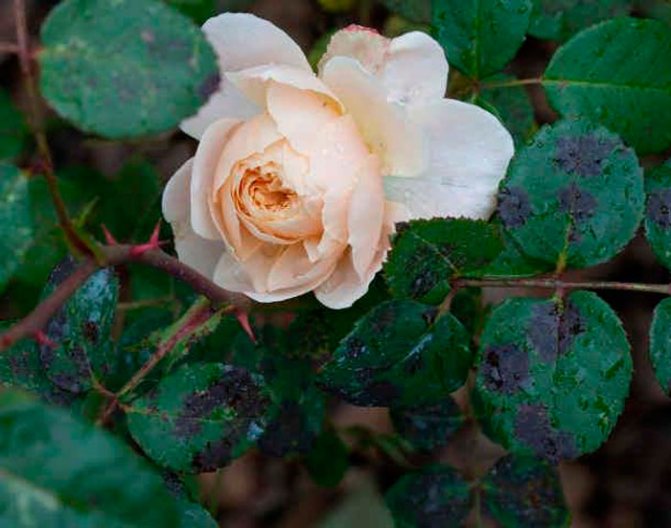

The causative agent of black spot on roses is the fungus Marssonina rosae, it is able to infect both the green stems of the bush and its foliage. Whitish-red spots appear on the front surface of the leaf plates, which eventually turn black, they are round and radiant, as if bordered by a fringe. Initially, the lower foliage is affected, but the infection quickly spreads throughout the bush. Affected leaf plates turn brownish-gray; later, their twisting, dying off and flying around are observed. The bush weakens and it has few or no buds. If the plant is very badly affected, then by the onset of the autumn period all the foliage can fly from it.
Immediately after detecting the first symptoms of the disease on the rose, cut off all diseased leaf plates from it, and also remove the fallen leaves from under the bush. Spray the plant regularly with a solution of a fungicidal preparation once every 7-12 days, for example: Abiga-Pica, Bordeaux liquid, Previkura, Skora, Topaz, Fundazola, Mankozeb, Thiophanat-methyl or Trifloxystrobin. The soil near the rose is spilled twice or three times with Fitosporin-M solution. In the autumn, when preparing a bush for wintering, all foliage is removed from it, and loose leaves are also collected, all this is destroyed by fire. Then the bare bush is sprayed with a solution of ferrous sulfate (3%). In springtime, before the growing season begins, cut off all branches and stems to healthy wood, and then spray the plant and soil near it with one of the products listed above.
Symptoms of black spot, or marsonina, on a rose are very similar to signs of the following diseases: brown spot, peronosporosis, phyllostictosis, cercosporosis, septoria, purple spot, ascochitis and sphacelloma. But you should not worry that you may misdiagnose a sick rose, since fungicidal preparations are used to treat all these diseases.
What else do you need to know
It will be helpful to take a look at our disease guide and at least skim through it to know what to expect.
And when you're done with the disease, move on to the pest control guide. This problem is also relevant for roses.
Fungicides are special preparations that are used to suppress and destroy diseases in your flowers. These pesticides are classified according to their chemical characteristics, method of application and action. An indispensable measure in preparing roses for winter is treatment for diseases, special preparations - fungicides for roses - will help in this.
Specialist advice
- Black spot can attack roses from rose hips growing nearby the site. If possible, transplant them as far as possible.
- Remove varieties from the garden that get sick much earlier and more severely than others suffering from black spot.
- According to many experienced flower growers, at least two actions must be strictly performed: spring spraying and removal of all foliage from the bushes and under them before sheltering for the winter. The result of the execution is felt immediately.
- Not a single variety possesses absolute immunity to disease. Therefore, they are divided into "susceptible" and "less susceptible." In general, modern hybrid varieties are more resistant to black spot.
- Prevention is of great importance. A variety that is resistant to black spot will hurt more often if not cared for properly. At the same time, due to the observance of preventive measures, it is possible to increase the resistance of the "susceptible" variety to the fungus.
Best neighbors for roses
Some growers like to plant some plants next to roses, but much depends on the climate and type of soil.
"Neighbors" will not cure black spot, but to a certain extent the bushes will protect against certain diseases and pests that emit sweet honeydew (aphids, thrips, etc.), on which a sooty fungus sits.
Other gardeners have not noticed the beneficial effect in their experience, and note the inconvenience of planting and controlling the spread of such plants.
Lemon catnip, Lavender, Tagetis "Grunt-control", but you can also flowering varieties, Oak sage.
ADDITIONS TO THE ARTICLE:
We wish you to encounter and fight black spot of roses as little as possible!
Ridomil Gold
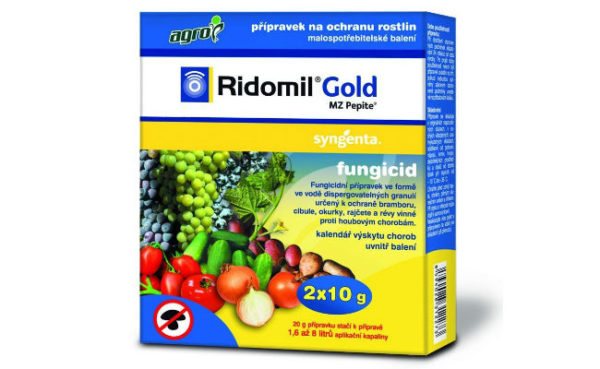

Two-component preparation based on mancoceb (64%) and mefenoxam (4%). Designed for the prevention and treatment of fungal diseases. It is especially effective for early detection of the disease. It is a beige granule that dissolves well in water. Mancozeb protects the plant from the outside, and mefenoxam from the inside.
- Can be used for prophylactic and therapeutic purposes
- Creates a resistant barrier against pests and protects even those parts of plants that have not been treated
- Penetrates quickly into the plant
- Possesses increased toxicity to humans and pets
- Possesses low efficiency
It is used for the prevention and control of the following diseases of roses: black spot, downy mildew, anthracnose, cercospora, etc.
Diseases of roses - description and methods of treatment
Roses have weak immunity, so they often suffer from viral, fungal ailments. Pathogens use old shoots, unharvested foliage as a winter shelter, and are activated under favorable conditions. Infections spread quickly, destroying aerial parts and roots.
Powdery mildew is a dangerous fungal disease that often affects roses. You can find out the disease by the white bloom on the greenery. The disease easily moves through neighboring bushes, quickly destroys the plant. The best treatment for powdery mildew is preventive autumn and spring boiling water treatment.
Dirty yellow spots on foliage are a symptom of rose fungus rust. Orange markings are found in the tops of the blades, shoots and buds. The disease moves through the garden, captures neighboring plants. Under favorable conditions for the pathogen, both conventional varieties and disease-resistant hybrids are at risk. The development of spores is inhibited by preventive treatments with copper sulfate.
An infectious burn is a dangerous disease that is common in temperate climates. Dark spots with a crimson border appear on the stems of roses, gradually turning into cracks and peeling of tissues. There is no cure for the disease, so gardeners choose preventive spraying in spring and autumn.
Gray rot is of a fungal nature, easily gets on roses with insects, birds and sediments.The disease affects only the weakened parts of the bushes, and may not show symptoms for months. You can recognize the ailment by the abundant ash panicles that appear on the buds, shoots of diseased plants. Preventive spring treatment and proper care will keep the flowers out of trouble.
Fundazol
Benomyl-based drug belonging to the class of benzimidazoles. Available as a white powder. Possesses high toxicity. Getting on plants stops the division of cells of fungi, causative agents of various diseases. Plant treatment takes place in the first three days. The protective effect lasts for another 4 days.
IMPORTANT: In addition to the positive effect on fungi, it can destroy aphids, leaf beetle larvae and spider mites.
- Effective over a wide temperature range
- Can be used for autumn processing of plants
- Possesses extremely high toxicity
- In case of an overdose, it inhibits the plant and can lead to its death
Read also How to make a box for the new year
Profit Gold
Contact fungicide based on famoxadone and cymoxanil. Provides reliable external protection. In addition to the active substance, the composition of the drug includes such macroelements useful for plants as zinc and manganese. Which improve the work of enzymes and take part in the synthesis of important compounds. It is a water-dispersible granules. Can be used to prepare roses for winter.
- Used to treat the most dangerous rose diseases
- Provides a long period of protection after use
- Toxic to humans and animals
Well protects plants from downy mildew, Alternaria and late blight.
Reasons for the appearance of black spots on roses
Rose is very whimsical. In case of mistakes in care, its leaves, and sometimes shoots, are affected by the fungus Marssonina rosae, the causative agent of black spot (PS). After powdery mildew, this is the most common rose problem. It is easy to determine the state of emergency: first, brown round spots with a yellow border are formed on the lower leaves, then they turn black, their shape spreads out like a blot on a blotter.
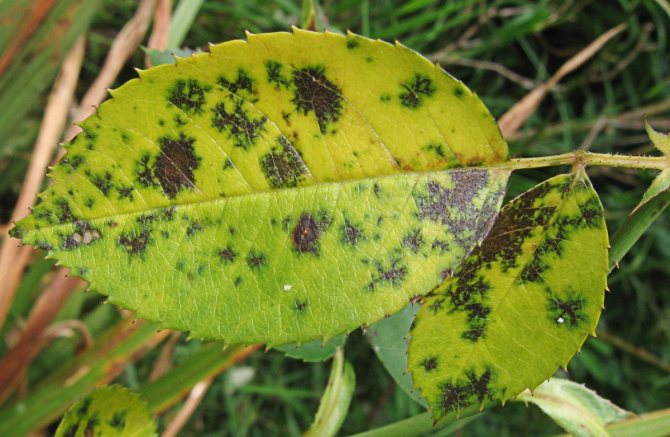

Black spot is a dangerous disease that requires immediate treatment
The disease most often develops at the end of the first wave of flowering against the background of:
- wet calm weather;
- unsuccessful planting of a rose in the shade;
- the presence of last year's foliage on the soil;
- thickening of the bush itself and plantings around it;
- excessive watering;
- overfeeding with nitrogen fertilizers.
Over time, the disease also captures the upper tier, the affected leaves turn yellow and fall off. A rose sick with an emergency is so weakened that it can freeze out in winter.
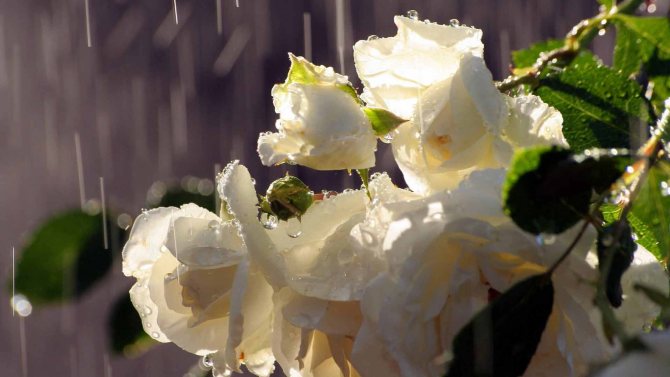

With heavy rainfall and a decrease in night temperatures, roses are affected by a variety of fungal diseases.
Topaz
Fungicide is a drug based on penconazole for the treatment of powdery mildew and other diseases. Sold as an emulsion concentrate.
- Applicable to a large species of plants
- Due to its pronounced action, it is possible to reduce the number of treatments
- Once inside the plants, it spreads through the capillaries to each area, even to the one where the solution did not get during spraying
- Toxic to some animals
- With frequent use, accumulates in the ground
Baktofit
Biological fungicide based on Bacillus subtilis strain IPM 215. Available in powder and suspension form. After entering the plant, the bacteria produce an antibiotic that suppresses the activity of pathogenic fungi.
- Environmentally friendly compared to chemicals
- Highly effective in rainy weather
- Low toxicity (class 4)
- Efficiency is 60% -70%, can only be used for prevention
- In dry weather, the effect deteriorates
Tiovit-Jet
Fungicide based on concentrated sulfur. Available in the form of granules.The drug is used to protect plants from powdery mildew and various pests.
Benefits:
- Adheres well to plants after application
- Easily soluble in water
- Can be applied to any crop
- Ecologically clean and free of phytotoxicity
Disadvantages:
- Low efficiency
Application
To protect roses from diseases, the granules (40 g) must be diluted in water (10 liters) and the plants must be sprayed.
Fitosporin
A new generation fungicide for combating bacterial diseases and diseases caused by pathogenic fungi. The active ingredient is Bacillus subtilis 26 D. It is produced in the form of powder, paste and aqueous suspension.
- Can be used at any stage of the growing season
- Has environmental value and is safe for humans
- Can be combined with other drugs
- Low cost
- In terms of its action, it is inferior to chemical preparations
- The active substance decomposes in the sun
Read more Fitosporin M for roses
Video "Fighting Plant Diseases with Fungicides"
Fungicidal agents are a great way to cure and prevent fungal diseases of roses. The modern range of fungicides is extensive. You can choose more powerful chemicals, or environmentally friendly products based on strains of beneficial bacteria. Each of them have their own advantages and disadvantages.
Types of fungicides, their advantages and disadvantages
Thanks to modern selection of roses, many varieties and hybrids have been bred that are resistant to fungal diseases. But, even they are not guaranteed against infection. In this regard, preventive care with fungicides will not interfere.
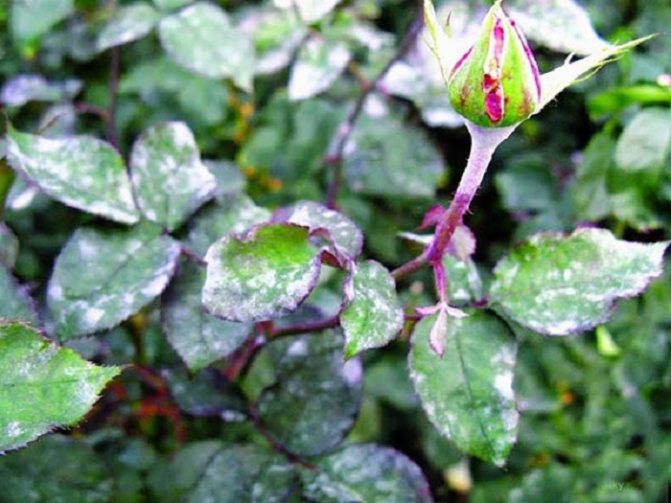

Diseases weaken roses and negatively affect decorativeness. If you do not fight them, they can destroy the plant.
Fungicides Are substances that suppress the development and spread of pathogens of fungal diseases (
Is it possible to spray roses
Since ancient times, it has been known how to spray roses: a tablespoon of baking soda was diluted in a glass of water and shrubs were sprayed five times a season. Also, according to the folk method, infusions of ash or mullein were made in a ratio of 1:20, which were used every week both for prophylactic purposes against fungal pathogens of flower diseases, and in the form of outside root feeding. At the moment, there are many chemicals than to spray roses to prevent various diseases and insect pests, but they must be alternated, as pathogens can become resistant to medicinal chemicals over time.
Review of commercial brands that are effective against fungal diseases of roses
Despite the huge variety of modern fungicides, copper-containing substances tested over the years are still widely used:
- Copper sulfate,
- Bordeaux liquid.
To help gardeners, many preparations are made with copper oxide, the preparation of which is much easier than, for example, Bordeaux mixture. Among them are such fungicides:
| Name | Application features | disadvantages | The cost |
Abiga Peak
It is used for prophylaxis as a solution of 50 g per 10 liters of water.
50 ml
Kurzat (analogue of Ordan)
Consumption rate in solution
30 - 50 g per 10 liters of water.
5 kg. Compared to similar drugs, higher consumption.
Oxyhom
The drug is effective against downy mildew of roses.
Dosage 20 g per 10 l of water
Read also Quail eggs how to cook for babies
10 g Contact fungicides are applied taking into account weather conditions.
For the treatment of rose diseases, such systemic fungicides:
- Bayleton (manufactured by Bayer CropScience - Germany) is sold in powder form. It is used against powdery mildew, black spot of roses and rust (
How to process roses in order to prevent disease
Note! The most popular remedy that brings the necessary result in the fight against diseases of a garden beauty, which has long been popular with professional flower growers, is the Bordeaux mixture.
Its universal composition of copper sulfate and hydrated lime effectively fights against all kinds of fungi and bacteria that can suddenly appear on the beauty's shrubs and provides maximum care for roses in summer. The main component of the solution - copper contributes to the intensive growth of bushes.
After processing roses, the solution lasts for a long time on the foliage, which contributes to its longer effectiveness. You cannot be mistaken when preparing Bordeaux liquid, since its strong concentration can burn the pet's leaves.
In early spring, when the shrub is freed from winter shelter with barely swelling buds, and in late autumn, roses are treated with a more concentrated 3% solution to destroy various bacteria and fungi. In late spring, summer and early autumn, treatment with a 1% solution of Bordeaux mixture for roses is sufficient in connection with preventive measures for flower diseases.
Preventive use of biofungicides
Recently, more and more gardeners adhere to environmentally friendly methods of plant protection. For this purpose, funds obtained from microflora or plant materials are used. Biofungicides are effective for the preventive care of roses. The duration of their action is inferior to chemical preparations, this is their disadvantage. On the other hand, they are harmless to humans, plants and the environment. In the fight against fungal diseases, gardeners prefer such means:
| Contact fungicide that inhibits the growth of proteins in the spores of pathogenic fungi. | Belongs to the third class of danger, requires compliance with safety measures during work. | RUB 45 / | |||
| Contains copper oxychloride in powder form. The drug is effective for prophylactic protection of roses for 10 - 12 days, then the treatment must be repeated. | Comes on sale in the form of a powder in bags of 1 kg or | RUB 1100 per | The combination of copper oxychloride and oxadixil provides double protection of roses from a wide range of fungal pathogens. | Do not mix with alkaline substances. | RUB 60 - |
| Name | Characteristic | disadvantages | The cost |
Mikosan - B
Norm - 100 ml per 10 l of water
3 weeks. Cannot be mixed with alkaline substances.
(analogue
Alirin - B)
Dosage - 10 g per 5 l of water
Trichodermin
(analogue
Glyocladin)
The rate of application into the soil before planting is 5 - 10 ml (depending on the size of the planting pit).
For irrigation - 100 ml per 10 liters of water.
Baktofit
The rate for the solution is
70 g per 10 l of water
Black spot on garden crops
Black spot of tomatoes
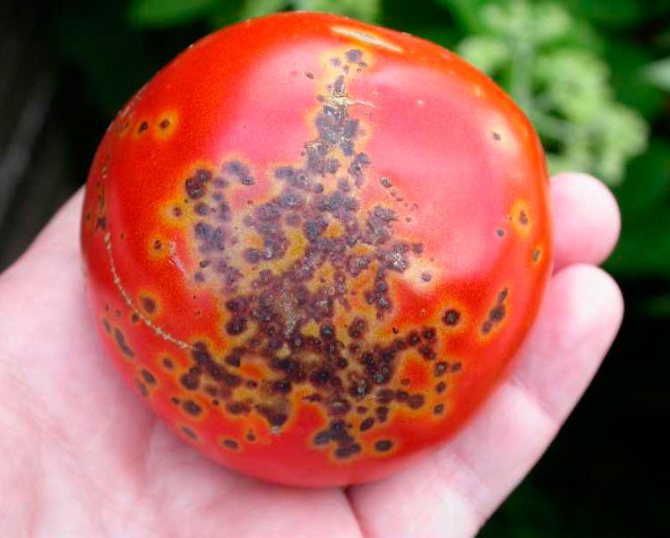

It is the gram-negative rod-shaped bacterium Xanthomonas vesicatoria that is the causative agent of bacterial black spot, which affects tomatoes grown both in the greenhouse and in the open field. In seedlings and young bushes, watery dotted spots appear on the surface of the foliage, which eventually increase to 0.1–0.2 cm, while their edge gradually turns yellow. On adult bushes, spots are usually located on the edges of the leaf plates, and also on the surface of the petioles and shoots. Fruits are also affected by mottling, on their surface raised points of a dark color with a watery border are formed. Over time, their size increases to 0.6-0.8 cm, and they become ulcers. The causative agent of the disease can be on plant debris and seeds for a long time, so do not forget to disinfect the seed before sowing.
The pathogen penetrates into the aerial parts of the bush through cracks, cracks and various mechanical damage. Further, the infection spreads rapidly through the tissues, from the moment the bush is affected by the disease and until the first symptoms appear, it takes from 3 to 5 days.On the surface of the fruit, dots appear later, and bushes located nearby the diseased plant become infected with black spot after about 15 days. The disease develops most actively at an air temperature of more than 25 degrees, but if it is cooler, then because of this, the infection will not go anywhere, but only a slowdown in its development will occur. Also, this bacterial disease begins to actively develop when the air humidity rises to 70-75 percent, but only if moisture gets on the aerial parts of the bush. Under these conditions, the development of the disease occurs very quickly.
The pathogen of spotting persists until a power source is present on the site. If, after harvesting, the site is carefully removed, then the death of the causative agent of the disease will occur in 4–5 weeks. To date, there are no varieties of tomatoes that are resistant to black spot. However, it has been observed that tomatoes that are not affected by fungal diseases rarely develop black spot.
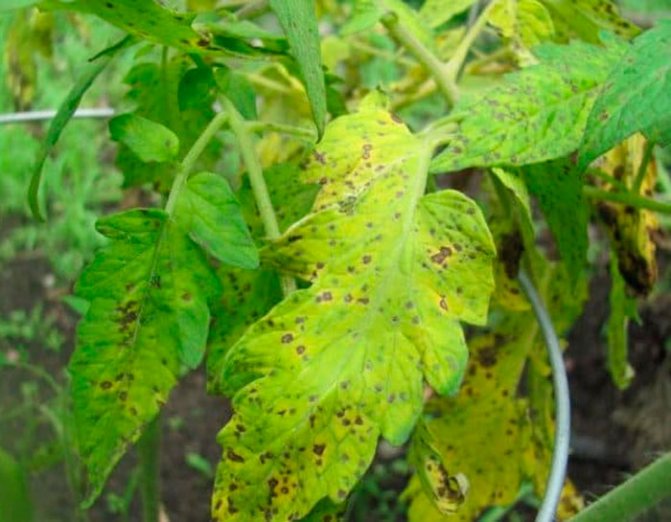

In the fight against infection, an important place is occupied by preventive measures, for example, pre-sowing preparation of seed, which consists in dressing it. Seeds can be disinfected in different ways:
- Seed material is poured with a solution of a fungicidal preparation, pulled out after 1 hour.
- Thirty-minute treatment in a solution of pink potassium permanganate.
- Prepare a solution of trisodium phosphate (for 100 mg of water, 12 grams of the drug) and immerse the seed in it for 1 hour. Then it is thoroughly washed under running water or in a sieve for 20-30 minutes.
- Soak the seeds for a third of an hour in very warm water (about 60 degrees).
These simple methods will help get rid of the infection that is present on the surface of the seed. However, another method is needed to get rid of the internal seed infection. To do this, the seed is immersed in a solution of the biological fungicide Planriz (1%) before sowing. Tomato seedlings, immediately before planting in open soil, are twice treated with a solution of Fitosporin-M, Baktofit, Planriz or Gamair. Phytolavin for processing tomatoes is very effective, it is able to exterminate pathogens and bacterial black spot, and apical rot, and bacterial cancer, and other diseases.
After planting tomatoes in open ground, they need to be systematically sprayed for prophylaxis with a solution of a product containing copper. For example, you can use Oxyhom, Hom, Bordeaux mixture solution (1%) and other means of similar action.
Black pepper spot
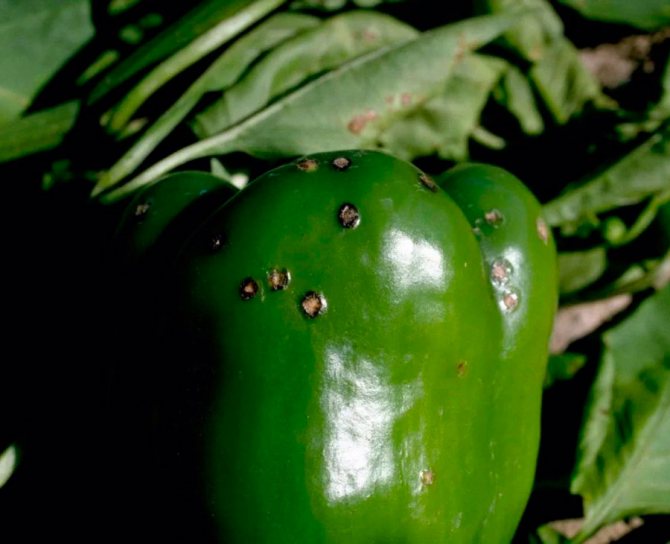

The causative agent of black bacterial spot on sweet peppers and on tomatoes is the same - it is Xanthomonas vesicatoria. Most often, the infection affects the young parts of the bush, resulting in pinpoint watery spots on foliage, fruits, shoots, cotyledons and petioles. As the disease progresses, the spots turn black, and their shape changes to round or angular. The size of such black spots, having a pale yellow border, is about 0.1–0.2 cm. The spots spread along the leaf veins, and yellowish necrosis with a dark border are formed in their middle. On the surface of the fruit, at first, raised black dots are also formed, which are surrounded by a watery border. As the disease progresses, the points increase to 0.6-0.8 cm and they become decaying sores. Protect peppers from black spot and treat it using the same methods and means as tomatoes.
Features of use in spring, summer in autumn
When roses are freed from winter shelter in spring, the first preventive treatment must be carried out.
Tip # 2. Do not wait until the roses show signs of disease. It is better to prevent infection than to cure disease.
For this purpose, roses are sprayed with copper-containing preparations or biofungicides. Intensive treatments are carried out in spring and early summer before the roses bloom.
Chemicals can burn the petals or leave unsightly stains on them. Therefore, during summer flowering, chemical fungicides are used in case of severe fungal infections.
In the fall, after pruning roses and harvesting fallen leaves, they carry out preventive treatment with preparations with copper or chemicals. The use of biofungicides does not make sense, since the living cultures that are part of them do not work at low temperatures.
Pest control
Processing has its own characteristics. If the previous season was not marked by an invasion of insects, the bushes do not need to be sprayed. If the attacks were massive, the rose garden is processed, coordinating the time of prophylaxis with the timing of the awakening of pests after winter.
Before the buds bloom, roses are treated from rose aphid and rose sawfly. Spraying shoots with "Fitoverm" or "Iskra-Bio" is effective. Against the rose-colored sawfly, two weeks later, re-treatment with "Aktara" is carried out. From aphids, spraying is repeated at the beginning of the formation of buds.
In the phase of leaf deployment, shoots are sprayed with "Nitrafen" to protect them from leafworms, and "Fufanon" or "Aktara" are used for shoots from rose leafhoppers.
Treatment against thrips is effective when the soil warms up to + 14 °. First, the soil is spilled with a solution of "Aktara", a week later the bushes are sprayed with "Confidor Extra".
Spider mite larvae wake up when the air temperature reaches + 18 ° C. All shoots are sprayed with Iskra-Bio, Vertimek or Akarin.
The amount of chemicals used in the rose garden is reduced by mulching the trunk circle with black material. The soil should be warmed up and dry by this time.
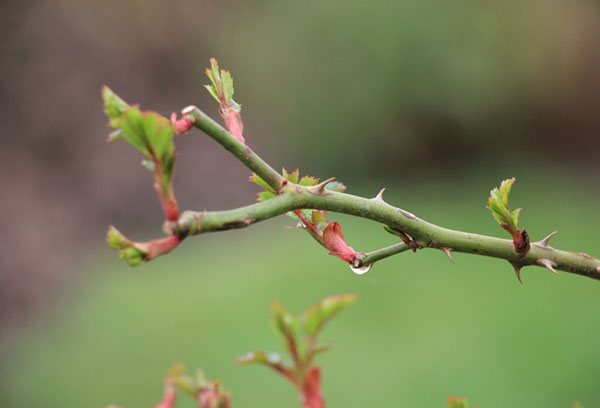

Category: "Questions and Answers"
Question number 1... Is there such a fungicide that will cure powdery mildew in roses in one go?
Unfortunately no. Fungal diseases are insidious in that microscopic pathogens are easily spread by wind and rain. This is why there is a constant threat of infection. Therefore, it is necessary to carry out preventive protection.
Question number 2... What is better biofungidides or chemicals?
Each category has positive and negative sides.
- Biologics are safe for the environment, but they do not cope with rapidly progressing diseases. They are used mainly for prophylaxis.
- Chemicals are used both to protect and treat roses. Since these are substances harmful to humans, their use is associated with the observance of precautionary measures.
Pest and disease control drugs
Not all chemicals are suitable for spraying roses. Flowering shrubs attract pollinators, so finding a safe remedy is important.
The sooner the eradication begins, the easier the recovery will be.
Effective preparations for treating roses in spring
Chemistry for insects is used from the start of shoot growth. During this period, neutral Iskra Bio, Fitoverm are suitable. After unfolding the leaf blade, spraying with Nitrafen is allowed. Before the buds appear and the buds open from pests, Aktara, Confidor and Akarin are used. Preventive measures take place at intervals of 2 weeks.

